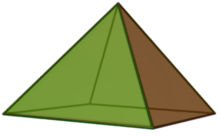Square pyramid
| Square pyramid | |
|---|---|
 | |
| Type | Johnson J92 - J1 - J2 |
| Faces | 4 triangles 1 square |
| Edges | 8 |
| Vertices | 5 |
| Vertex configuration | 4 of 32.4 1 of 34 |
| Symmetry group | C4v |
| Dual polyhedron | self |
| Properties | convex |
In geometry, a square pyramid is a pyramid with a square base and triangular sides. If the sides are all equilateral triangles, then the pyramid is one of the Johnson solids (J1), and can be thought of as half of an octahedron. The 92 Johnson solids were named and described by Norman Johnson in 1966.
Other square pyramids, such as the Great Pyramid of Giza, are not mathematically similar to the Johnson solid; the pyramid at Giza, for example, has isosceles sides of base 756 feet and slant height 719 feet. That pyramid has the interesting property that the slant height (along the bisector of a face) is very nearly equal to the golden ratio times the height, in which case the area of each triangular face is equal to the square of the pyramid's height.
Area and volume
If the faces of the square pyramid are regular, that is, equilateral triangles, then the solid can be characterized by a single edge-length parameter a. The area A (including all five faces) and the volume V of such a pyramid are:
For square pyramids in general, with base length l and height h, the volume is:
External link



